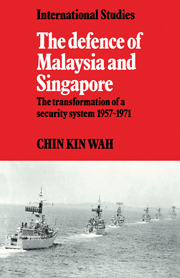Book contents
- Frontmatter
- Contents
- Preface
- Acknowledgements
- List of abbreviations
- Note on currency units
- 1 Introduction
- 2 Pre-treaty defence relations
- 3 Decolonisation and the institution of the defence agreement
- 4 The extension of AMDA
- 5 The external testing of AMDA
- 6 Towards a closing of ranks
- 7 The fractured axis
- 8 Britain weighs anchor
- 9 From AMDA to the five-power defence system
- 10 Conclusions
- Postscript on five-power arrangements
- Notes
- Bibliography
- Index
6 - Towards a closing of ranks
Published online by Cambridge University Press: 07 October 2011
- Frontmatter
- Contents
- Preface
- Acknowledgements
- List of abbreviations
- Note on currency units
- 1 Introduction
- 2 Pre-treaty defence relations
- 3 Decolonisation and the institution of the defence agreement
- 4 The extension of AMDA
- 5 The external testing of AMDA
- 6 Towards a closing of ranks
- 7 The fractured axis
- 8 Britain weighs anchor
- 9 From AMDA to the five-power defence system
- 10 Conclusions
- Postscript on five-power arrangements
- Notes
- Bibliography
- Index
Summary
Malaysia's severing of diplomatic relations with Indonesia and the Philippines opened a new phase in Confrontation marked by heightened physical and political conflict between the antagonists. Intensification of the threat led to a corresponding change in the nature and speed of intra-AMDA responses culminating in the closing of ranks among the allies.
With the evident failure of a political settlement, Jakarta began to shift the emphasis of its tactics in a military direction. In August, Indonesian-based terrorists appeared for the first time in Sarawak's Fifth Division, while encounters in Sarawak resulted in the first fatal casualty (of British officer rank) in Borneo. In mid-September the Indonesian army announced that ‘special battle units’ had been dispatched to territories bordering Sarawak. And, when the Federation was proclaimed, anti-Malaysia riots erupted in Jakarta and Medan. In Jakarta, the Malayan and British embassies, as well as British homes and property, were attacked (the British embassy being set on fire) and British firms progressively nationalised.
The day after Malaysia's inauguration, Kuala Lumpur proclaimed a ‘state of preparedness’ and established a Joint Defence Council under the Tunku's chairmanship. The council decided to call up the reserves, increase the armed forces (especially the territorials) and revive the special constabulary. Singapore's reaction, however, was decidedly low-key. Lee Kuan Yew described the Indonesian demonstrations as a contemporary ‘ritual of showing disapproval’. As far as Singapore was concerned, it was ‘business as usual’.
- Type
- Chapter
- Information
- The Defence of Malaysia and SingaporeThe Transformation of a Security System 1957–1971, pp. 82 - 101Publisher: Cambridge University PressPrint publication year: 1982

